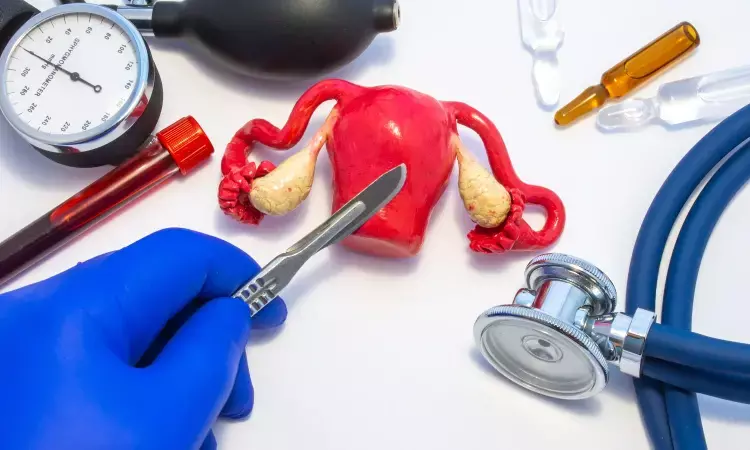- Home
- Medical news & Guidelines
- Anesthesiology
- Cardiology and CTVS
- Critical Care
- Dentistry
- Dermatology
- Diabetes and Endocrinology
- ENT
- Gastroenterology
- Medicine
- Nephrology
- Neurology
- Obstretics-Gynaecology
- Oncology
- Ophthalmology
- Orthopaedics
- Pediatrics-Neonatology
- Psychiatry
- Pulmonology
- Radiology
- Surgery
- Urology
- Laboratory Medicine
- Diet
- Nursing
- Paramedical
- Physiotherapy
- Health news
- Fact Check
- Bone Health Fact Check
- Brain Health Fact Check
- Cancer Related Fact Check
- Child Care Fact Check
- Dental and oral health fact check
- Diabetes and metabolic health fact check
- Diet and Nutrition Fact Check
- Eye and ENT Care Fact Check
- Fitness fact check
- Gut health fact check
- Heart health fact check
- Kidney health fact check
- Medical education fact check
- Men's health fact check
- Respiratory fact check
- Skin and hair care fact check
- Vaccine and Immunization fact check
- Women's health fact check
- AYUSH
- State News
- Andaman and Nicobar Islands
- Andhra Pradesh
- Arunachal Pradesh
- Assam
- Bihar
- Chandigarh
- Chattisgarh
- Dadra and Nagar Haveli
- Daman and Diu
- Delhi
- Goa
- Gujarat
- Haryana
- Himachal Pradesh
- Jammu & Kashmir
- Jharkhand
- Karnataka
- Kerala
- Ladakh
- Lakshadweep
- Madhya Pradesh
- Maharashtra
- Manipur
- Meghalaya
- Mizoram
- Nagaland
- Odisha
- Puducherry
- Punjab
- Rajasthan
- Sikkim
- Tamil Nadu
- Telangana
- Tripura
- Uttar Pradesh
- Uttrakhand
- West Bengal
- Medical Education
- Industry
Robotic and conventional laparoendoscopic single-site hysterectomy safe and feasible for large uterus: Study

A new study published in the European Journal of Obstetrics, Gynecology and Reproductive Biology found that for big uteruses, both robotic and traditional laparoendoscopic single-site hysterectomy were safe, practical, and produced satisfactory surgical results.
In the gynecological setting, minimally invasive surgery like the single-site method (laparoscopic or robotics-assisted) has shown several benefits in the management of both benign and malignant diseases. When compared to standard laparotomy surgery, this surgical technique has well-known advantages, including a smaller abdominal scar and a lower rate of wound complications, postoperative discomfort, and hospitalization.
Also, the single-site procedure reduces scarring from surgical incisions and abdominal stress, as well as the appearance of potential side effects (tissue, nerve, and artery damage), improving the cosmetic results following surgery.
The challenges of traditional laparoendoscopic single-site surgery can be significantly reduced by the robotic surgical system with improved ergonomics, tremor filtering, flexible tools, and greater visibility. Thus, to determine if robotic laparoendoscopic single-site surgery using the da Vinci Xi system was the best method for conducting benign hysterectomy on a big uterus, Yu Chen and team carried out this study.
This retrospective study included patients with uterine weights more than 280 g who had transumbilical single-site hysterectomy, with or without da Vinci Xi system, performed between May 2021 and September 2023 were included in the study. Perioperative outcomes were assessed between the two groups following propensity score matching to equalize the baseline characteristics.
Each group consisted of 74 patients after a 1:1 propensity score match. No patient needed more ports, a multi-port laparoscopy, or a conversion to a laparotomy. The robotic group had a considerably reduced postoperative complication rate (4.1 % vs 13.5%) and a significantly longer exhaust time (2.4 ± 0.7 vs 2.0 ± 0.7 days) when compared to the conventional group.
Even though the robotic group had bigger uterine weights (412.5 vs 394.0 g) and a greater percentage of severe adhesion (33.8 % vs 17.6 %), there were no significant differences in operating time (183.6 ± 53.6 vs 178.2 ± 55.4 min), blood loss (100.0 vs 50.0 mL), or intraoperative complications (1.4% vs 0%). Overall, for large uteruses, both robotic and traditional laparoendoscopic single-site hysterectomy were safe, practical, and produced satisfactory surgical results.
Reference:
Chen, Y., Zheng, Y., Yang, F., Wang, Q., Liu, J., Chen, S., & Yang, X. (2025). Comparison of robotic and conventional laparoendoscopic single-site hysterectomy for large uterus using da Vinci Xi system: A propensity score matching analysis. European Journal of Obstetrics, Gynecology, and Reproductive Biology, 307, 252–257. https://doi.org/10.1016/j.ejogrb.2025.02.036
Neuroscience Masters graduate
Jacinthlyn Sylvia, a Neuroscience Master's graduate from Chennai has worked extensively in deciphering the neurobiology of cognition and motor control in aging. She also has spread-out exposure to Neurosurgery from her Bachelor’s. She is currently involved in active Neuro-Oncology research. She is an upcoming neuroscientist with a fiery passion for writing. Her news cover at Medical Dialogues feature recent discoveries and updates from the healthcare and biomedical research fields. She can be reached at editorial@medicaldialogues.in
Dr Kamal Kant Kohli-MBBS, DTCD- a chest specialist with more than 30 years of practice and a flair for writing clinical articles, Dr Kamal Kant Kohli joined Medical Dialogues as a Chief Editor of Medical News. Besides writing articles, as an editor, he proofreads and verifies all the medical content published on Medical Dialogues including those coming from journals, studies,medical conferences,guidelines etc. Email: drkohli@medicaldialogues.in. Contact no. 011-43720751


